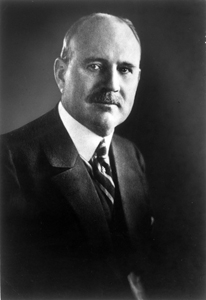
Charles Williams Nash (January 28, 1864 – June 6, 1948) who was an American automobile entrepreneur who founded the Nash Motors company. He was the former General Motors president and played a major role in building up General Motors and co-founding Buick Motor Company.
Charles Nash was born into a poor farming family in Illinois. His parents separated when he was six years old and abandoned him. As a result of a court order, he worked as a farmhand in Michigan as an indentured servant under an agreement that was to last until he was 21.
He had only three months of schooling per year while he was “bound out” to perform farm chores. At age 12, Nash ran away and became a farmhand on several farms in Michigan were he learned the carpentry trade. He moved to Flint, Michigan.
In 1890 at the age of 26, he was hired by William C. Durant of the Flint Road Cart Company, which later became the Durant-Dort Carriage Company and the co-founderd General Motors. Charles Nash earned $1 per day as an upholstery stuffer. Within six months, he was promoted to superintendent of the factory. Within 10 years, Nash became vice president and general manager of the Durant-Dort Carriage Company. By 1910, the Durant-Dort Carriage Company was building automobile bodies for the Buick brand of General Motors. Durant was president of the new General Motors Corporation and appointed Nash as vice-president of Buick on 13 December 1910.
In late 1912, William Durant was dismissed by the General Motors board and Nash was appointed president. Nash had restored GM to organizational stability and financial health. By late 1915 and early 1916, William Durant attempted to reassert his control over the company and Nash was caught in the power struggle between Durant and bankers. By May 1916, Durant had regained controlled the majority of voting stock. He offered Nash a $1 million annual salary to remain with the automaker.
After his clash with Durant, Nash resolved never again to work for someone else. Nash learned that the heirs of the Thomas B. Jeffery Company were anxious to retire. In 1916, Charles T. Jeffery sold the company to Charles Nash who renames the company, Nash Motors.
Nash bought out the automaker in August 1916 with a down payment check of half million dollars and the total deal worth $5 million (some reports indicate the price was $9 million). One of the first major investors was Alfred P. Sloan, Sloan was the long-time president, chairman and CEO of General Motors. While Thomas B. Jeffery Company had total stock of $3 million, the newly incorporated Nash Motors became a major force with a capital stock of almost $24 million on 29 July 1916.
The 1917 Nash Model 671 was the first automobile to bear the name of the new company’s founder. Nash Motors became successful almost immediately, with sales totaling 31,000 trucks and cars by 1919. Nash negotiate procurement contracts with the United States Army during World War I that made the company one of the largest producers of trucks in the nation.
In addition to running his own company, Charles Nash also served as president of the luxury automaker LaFayette Motors. LaFayette was founded in 1919 and originally headquartered in Mars Hill, Indianapolis, Indiana, and made luxury motor cars, beginning in 1920. LaFayette innovations include the first electric clock in an motorcar. LaFayette remained separate, although Nash Motors was the principal LaFayette Motors stock holder.
Charles Nash retired as president of Nash Motors in 1932, but remained board chairman. Nash began looking for his successor, he turned to George W. Mason upon the recommendation of Walter Chrysler. In order to hire Mason, Nash had to acquire the Kelvinator Appliance Company were Mason served as the Chairman and CEO. Nash and Mason came to terms and the deal was announced in November 1936.
After twenty years of success in running his company, Nash turned it over in 1937 and retired from his company to live in California.
He died in 1948 at the age of 84 in Beverly Hills.
Nash pioneered some important innovations; in 1938 they debuted the heating and ventilation system which is still used today, unibody construction in 1941, seat belts in 1950, a US built compact car in 1950. During World War II, Nash-Kelvinator greatly expanded to manufacture aircraft engines and parts. Nash-Kelvinator ranked 27th among United States corporations in the value of World War II production contracts.

You must be logged in to post a comment.